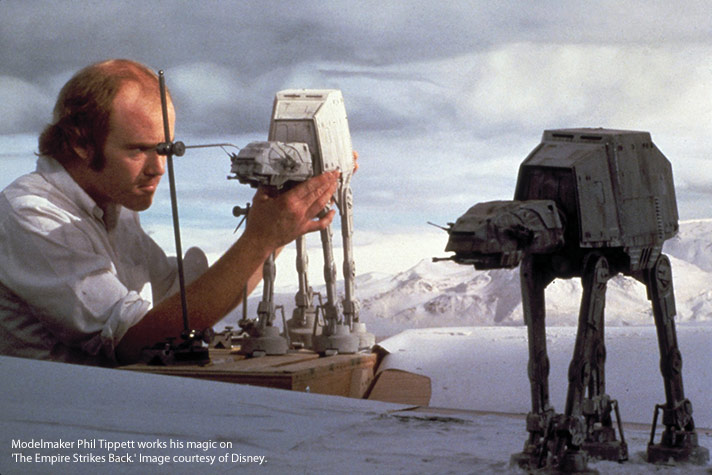The Unfettered Critic – October 2022
Time keeps on slippin’, slippin’, slippin’
Into the future…” ~Steve Miller, 1976
Slippin,’ in fact, happens all the time.
Let’s say you come up with the most amazing, ground-breaking technology ever seen. Your awesome innovation changes everything it touches and is applauded as true magic.
Then, in the blink of a decade or two (your mileage may vary), your groundbreaking innovation is leapfrogged by newer magic, a plethora of innovations that you yourself have inspired. In fact, the more groundbreaking your invention is, the more likely it is to be struck down by its own offspring.
Which brings us to our favorite documentary series (of this decade) (so far): Light & Magic, a fascinating six-parter on Disney+ about the creation of modern visual effects.
The documentary opens in the mid-1970s, when director/writer George Lucas set out to make Star Wars, a movie that would forever change the motion picture industry. Although Twentieth Century Fox had provided Lucas with the funding he needed, he quickly realized that there was no existing way to visually present the space opera he had in mind.
Which meant he’d have to invent it.
Part One of the series, fittingly titled “Gang of Outsiders,” shows us how Lucas collected a group of young, unknown (and untested) artists and tech geeks—among them soon-to-be legends John Dykstra, Dennis Muren, Richard Edlund, Joe Johnston and Phil Tippett—to figure it out. He set them up in a cramped Van Nuys, CA warehouse and instructed them, God-to-Moses style, to “Go Ye and Create Hardware And Technology That Will Amaze The World.”
Lucas named the facility “Industrial Light & Magic” (ILM), allotted the group a budget of $1,000,000, and went overseas to shoot Star Wars’ live-action scenes. The visionary group worked and played unsupervised for months. Predictably, there was a little too much play at times (with shenanigans more akin to Animal House than “serious cinema”). But there also were hardcore achievements, enough to make Star Wars’ iconic opening shot—a mind-blowingly large and very detailed spaceborne vessel passing overhead, only to be followed by an even larger and more detailed spaceship—as miraculous to 1977 audiences as the parting of the Red Sea was to audiences of The Ten Commandments some twenty years earlier.
Thus began the legend of ILM, instantly the world’s preeminent visual image house. In a way, it was not unlike Thomas Alva Edison’s “Invention Factory” in Menlo Park, NJ in the late 19th century. That facility provided a gathering point for innovative scientists, designers, and machinists to collaborate in researching, developing, and manufacturing new technology. During his lifetime, Edison accumulated over a thousand patents, advancing technology in telecommunications, lighting, sound recording, motion pictures, storage batteries, and voting machines.
At first glance, ILM’s achievements may seem less staggering in comparison, but the inventions by the ragtag team at Lucas’s facility (later relocated to Northern California) undeniably changed our digital world. Their tinkering led to digital editing, advanced computer graphics, Photoshop, and Pixar.
Later episodes of this docuseries, directed by writer/filmmaker Lawrence Kasdan (The Big Chill, Body Heat), follow ILM’s progress as the team developed the “impossible” yet necessary tech to handle Raiders of the Lost Ark, Star Trek II: The Wrath of Khan, Jurassic Park, and hundreds more. And as time slipped into their future, each brilliant innovation they created gave way to more brilliant innovations. Some of the geniuses learned new tricks, and moved in new directions. Others found themselves redundant, outpaced by inevitable evolution, like dinosaurs left behind at the tar pits. Light & Magic is commendably honest about the experiences of these former geeks, and is well-worth the price of admission for the memories it will stir within your mind.

 Paula and Terry identify as writers, with an ever-increasing number of published works to support the supposition. They live a primarily pastoral life in the enchanted town of Jacksonville.
Paula and Terry identify as writers, with an ever-increasing number of published works to support the supposition. They live a primarily pastoral life in the enchanted town of Jacksonville.